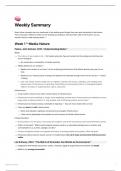Summary
Summary Media, Time and Space
- Course
- Institution
This is the whole summary for the course media, time and space. It include all reading notes, Lecture notes and my own thinking and writing. With this summary and notes, I got a 9.7 on the exam. Wish you good luck!
[Show more]



